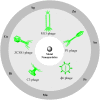The use of phages for the biosynthesis of metal nanoparticles and their biological applications: A review
- PMID: 38837580
- PMCID: PMC11149492
- DOI: 10.1111/jcmm.18383
The use of phages for the biosynthesis of metal nanoparticles and their biological applications: A review
Abstract
Nowadays, the use of biological methods of synthesis of nanoparticles as substitutes for methods that use high energy and consumption of expensive and dangerous materials is of interest to researchers all over the world. Biological methods of synthesising metal nanoparticles are very important because they are easy, affordable, safe, environmentally friendly and able to control the size and shape of nanoparticles. One of the methods that is of interest today is the use of bacteriophages as the most abundant organisms in nature in the synthesis of metal nanoparticles. Nanomaterials biosynthesized from phages have shown various clinical applications, including antimicrobial activities, biomedical sensors, drug and gene delivery systems, cancer treatment and tissue regeneration. Therefore, the purpose of this review is to investigate the biosynthesis of metal nanoparticles with phages and their biomedical applications.
Keywords: biological applications; biosynthesis; metal nanoparticles; phage.
© 2024 The Author(s). Journal of Cellular and Molecular Medicine published by Foundation for Cellular and Molecular Medicine and John Wiley & Sons Ltd.
Conflict of interest statement
The author has no conflict of interest to declare.
Figures
Similar articles
-
Biogenic nanomaterials: Synthesis, characterization, growth mechanism, and biomedical applications.J Microbiol Methods. 2019 Feb;157:65-80. doi: 10.1016/j.mimet.2018.12.008. Epub 2018 Dec 13. J Microbiol Methods. 2019. PMID: 30552971 Review.
-
Recent Trends in Biologically Synthesized Metal Nanoparticles and their Biomedical Applications: a Review.Biol Trace Elem Res. 2024 Jul;202(7):3383-3399. doi: 10.1007/s12011-023-03920-9. Epub 2023 Oct 25. Biol Trace Elem Res. 2024. PMID: 37878232 Review.
-
Biological properties of "naked" metal nanoparticles.Adv Drug Deliv Rev. 2008 Aug 17;60(11):1289-1306. doi: 10.1016/j.addr.2008.03.013. Epub 2008 Apr 10. Adv Drug Deliv Rev. 2008. PMID: 18501989 Review.
-
Recent Developments in the Facile Bio-Synthesis of Gold Nanoparticles (AuNPs) and Their Biomedical Applications.Int J Nanomedicine. 2020 Jan 16;15:275-300. doi: 10.2147/IJN.S233789. eCollection 2020. Int J Nanomedicine. 2020. PMID: 32021180 Free PMC article. Review.
-
An effective antibiofilm strategy based on bacteriophages armed with silver nanoparticles.Sci Rep. 2024 Apr 20;14(1):9088. doi: 10.1038/s41598-024-59866-y. Sci Rep. 2024. PMID: 38643290 Free PMC article.
Cited by
-
Green nanoscience for healthcare: Advancing biomedical innovation through eco-synthesized nanoparticle.Biotechnol Rep (Amst). 2025 Aug 12;47:e00913. doi: 10.1016/j.btre.2025.e00913. eCollection 2025 Sep. Biotechnol Rep (Amst). 2025. PMID: 40895589 Free PMC article. Review.
-
Phage treatment of multidrug-resistant bacterial infections in humans, animals, and plants: The current status and future prospects.Infect Med (Beijing). 2025 Feb 5;4(1):100168. doi: 10.1016/j.imj.2025.100168. eCollection 2025 Mar. Infect Med (Beijing). 2025. PMID: 40104270 Free PMC article. Review.
-
Biosynthesized Metal Nanoparticles as a High-Potential Tool in Bone Regenerative Medicine: A Review.Biol Trace Elem Res. 2025 Aug 27. doi: 10.1007/s12011-025-04800-0. Online ahead of print. Biol Trace Elem Res. 2025. PMID: 40859106 Review.
-
Simple, rapid, and efficient purification of M13 phages: The Faj-elek method.PLoS One. 2025 Jun 6;20(6):e0325621. doi: 10.1371/journal.pone.0325621. eCollection 2025. PLoS One. 2025. PMID: 40478842 Free PMC article.
-
Biotechnological advances in microbial synthesis of gold nanoparticles: Optimizations and applications.3 Biotech. 2024 Nov;14(11):263. doi: 10.1007/s13205-024-04110-7. Epub 2024 Oct 7. 3 Biotech. 2024. PMID: 39387004 Review.
References
-
- Sekhri A, Sharma R, Bharti R. Nanoparticles: synthetic techniques, surface deposition and applications. AIP Conference Proceedings. Vol 2535. AIP Publishing; 2023.
-
- Dousari AS, Amirheidari B, Dousari FS, Karbalaei M. Nanotechnology, a novel strategy in detecting Streptococcus agalactiae, and its antibacterial, antibiofilm, and antiquorum sensing properties. Appl Organomet Chem. 2023;38:e7329.
-
- Sadeghi Dousari A, Talebi Bazmin Abadi A, Forootanfar H, Shakibaie M. Biosynthesis of bismuth nanoparticles and its synergistic effect with antibiotics against Escherichia coli and Klebsiella pneumoniae . Pathobiol Res. 2022;25:23‐32.
Publication types
MeSH terms
LinkOut - more resources
Full Text Sources



